Content
- The structure, function of the adrenal glands
- What the adrenal glands are responsible for in the body of women
- The main types of adrenal diseases and their symptoms, causes of development
- Hyperaldosteronism
- Insufficiency of the adrenal cortex
- Pheochromocytoma
- Addison's disease
- Itsenko-Cushing's disease
- Nelson's syndrome
- Adrenal tuberculosis
- Inflammation
- Hyperplasia of the adrenal cortex
- Cyst
- Malignant tumor
- Diagnostic methods
- Methods for treating adrenal diseases
- Drug therapy
- Non-drug treatment
- Surgery
- Why are adrenal diseases dangerous, consequences and predictions
- Adrenal video
Adrenal problems can have serious health consequences for women, as they are involved in the regulation of many functions in the body. Common diseases of the endocrine gland have their own causes, symptoms and require specific treatment tactics.
The structure, function of the adrenal glands
The adrenal gland is a very small endocrine gland, weighing about 6 grams, located at the top of each kidney - a kind of "crown".
Each gland consists of a cortex, which is 2/3 of the size of the organ, and the inner part, the medulla or the nucleus of the gland. The adrenal cortex has the ability to absorb and produce cholesterol.
The cortical layer or mantle is divided into 3 parts, and each produces hormones:
- One layer (glomerular) secretes aldosterone, a hormone that affects kidney function. It is responsible for conserving water and salt in the body. Aldosterone regulates blood pH by controlling electrolyte levels.
- The middle layer (bundle) secretes steroid hormones. One of them, cortisol, is involved in metabolic processes: metabolism in the body, fats, proteins and blood sugar, and controls the sleep-wake cycle. It is released during times of stress to help the body get energized and better deal with an emergency.
- The cells of the third layer (mesh) secrete male and female sex hormones regardless of gender. These are precursor hormones that are converted into female hormones (estrogens) in the ovaries and male hormones (androgens) in the testes.
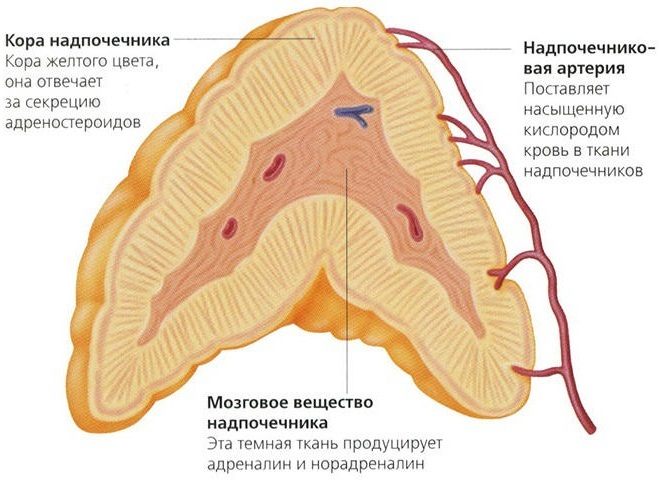
The adrenal nucleus - the medulla - mainly secretes the hormones adrenaline and norepinephrine. They are able to increase heart rate and strength, blood flow to muscles and brain, relax airway smooth muscles, and promote glucose (sugar) metabolism. They also control the constriction of blood vessels, helping to maintain blood pressure and raising it in response to stress.
Adrenaline and norepinephrine are activated in situations of physical and emotional stress, when the body requires additional resources and energy to withstand unusual stress.
The adrenal glands are controlled by the pituitary gland in the head. It is the main regulator of the endocrine glands. The adrenal glands produce too much or too little hormones as a result of disturbances in the pituitary gland, when it begins to transmit abnormal signals to the endocrine glands. Physiologically, the role of the adrenal glands is to regulate, balance hormones and systems in the body as a whole.
Adrenal problems (symptoms in women with some diseases are identical to those of men) create hormonal imbalances and affect health.
What the adrenal glands are responsible for in the body of women
A woman's body is largely dependent on hormones. First, menstruation is regulated by them. Secondly, the state of the woman's endocrine system depends on them. This is an important component that affects a woman's ability to get pregnant. The main female hormones are progesterone and estrogens.
Progestins affect the formation of female mammary glands, the possibility of pregnancy. Estrogens are responsible for bone strength, skin condition, regulation of water-salt metabolism.
The main types of adrenal diseases and their symptoms, causes of development
Adrenal problems (symptoms in women often include weight loss) affect women's health. Dysfunction is caused by various diseases of the adrenal or pituitary gland. Symptoms of adrenal gland involvement tend to be mild at first, but tend to get worse and more frequent over time.
Hyperaldosteronism
The disease develops due to excessive secretion of aldosterone. It has a primary and secondary stage of development, arises as a result of a tumor or hyperplasia of the adrenal gland itself. Patients may have high levels of aldosterone, low levels of renin and potassium (hypokalemia).
A clinic developing in a patient is characterized by:
- fatigue, headache;
- high blood pressure;
- hypotension;
- partial or complete paralysis;
- muscle cramps and muscle fatigue;
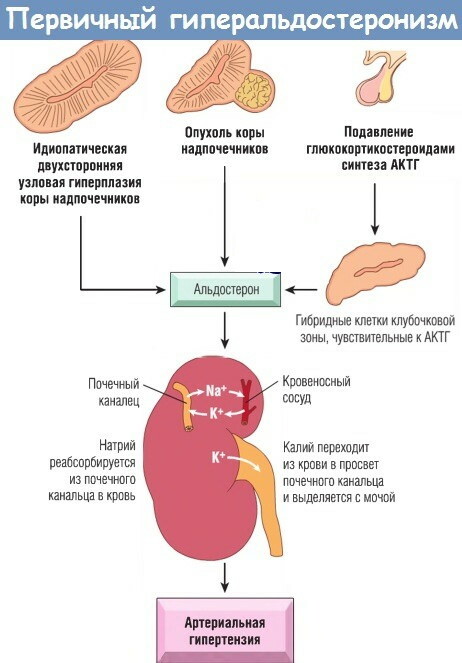
- repeated urination and constant thirst;
- hyperthermia and basal metabolism.
Insufficiency of the adrenal cortex
When the adrenal cells responsible for the secretion of hormones degenerate as a result of changes in the glandular tissues of the organ, chronic failure occurs.
There is a decrease in the secretion of hormones, certain symptoms appear:
- blood pressure can drop dramatically;
- impaired renal function;
- heart rate may decrease;
- the level of sugar in the blood decreases;
- appetite decreases;
- weakness appears, a constant breakdown.
But since a person has 2 adrenal glands, if one is completely damaged, the other gland will begin to secrete additional hormones, which compensates for the dysfunction of the affected gland.
Causes of adrenal gland destruction:
- An autoimmune process, when antibodies are produced that destroy the glands. This occurs in people suffering from autoimmune diseases, such as: ovarian failure in women due to autoimmune background, decreased thyroid function, type 1 diabetes mellitus.
- Suppression of the hypothalamic-pituitary-adrenal axis. Occurs in patients undergoing long-term treatment with high doses of steroid drugs.
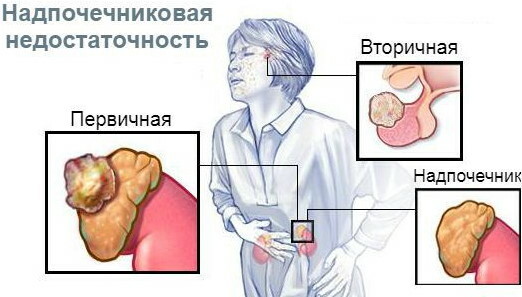
- Serious infection is a common cause of adrenal gland damage.
- A rare complication after treatment with an anticoagulant, heparin, which results in bleeding in the adrenal gland, causing its destruction.
- Various tumors that send metastases to the adrenal gland and cause its destruction.
- After an accident or head injury, adrenal glands.
- Viruses such as HIV that attack and destroy the adrenal gland.
Pheochromocytoma
A tumor that develops in the medulla of the endocrine glands, contributing to the excess production of adrenaline or norepinephrine. Tumors are benign in 90% of cases, but cause many symptoms, including high blood pressure, heart palpitations, sweating, headaches, shortness of breath, and pale skin. Some patients lose weight dramatically, experience latent anxiety, and develop constipation.
Addison's disease
Problems with the adrenal glands (symptoms in women, as well as in men, can occur at any age) sometimes manifest themselves as a rare pathology. Addison's disease, or primary adrenal insufficiency, is an autoimmune disease that develops when the adrenal glands are unable to produce enough cortisol, or aldosterone. It is a self-destructive disease in which the immune system attacks adrenal tissue.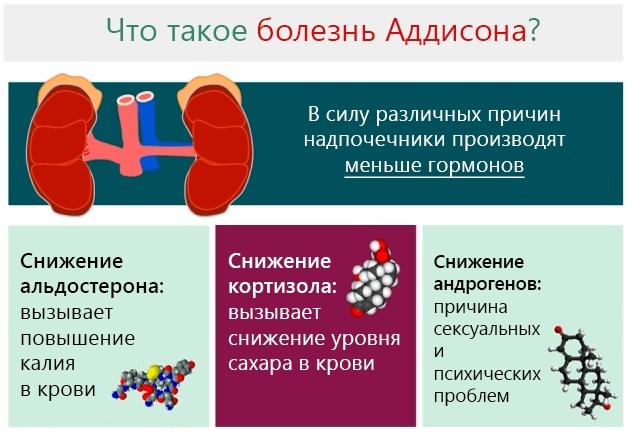
How does the disease manifest itself:
- decrease in AD;
- disruption of the digestive tract;
- weakness, lack of appetite;
- frequent fatigue;
- the appearance of pigmentation on the mucous membrane.
Itsenko-Cushing's disease
A disease in which there is an excess of cortisol in the body. The main reason is the failure of the hypothalamic-pituitary structure. It is often accompanied by high mortality if the disease is not properly diagnosed and treated effectively. Conventional treatment includes surgery to remove the adrenal adenoma, and in cases where there is no improvement after surgery, radiation sessions or adrenal resection are performed.
Nelson's syndrome
Signs of Nelson's syndrome are due to the increased growth of adrenocorticotropic hormone and the pressure of the tumor on the surrounding structures, which interferes with the release of other pituitary hormones. This occurs after removal of the adrenal glands in Itsenko-Cushing's disease. The disease is characterized by glandular insufficiency, hyperpigmentation of the skin, mucous membranes and the presence of a pituitary tumor.
Adrenal tuberculosis
Tuberculous adrenalitis is the result of an adrenal infection caused by Mycobacterium tuberculosis.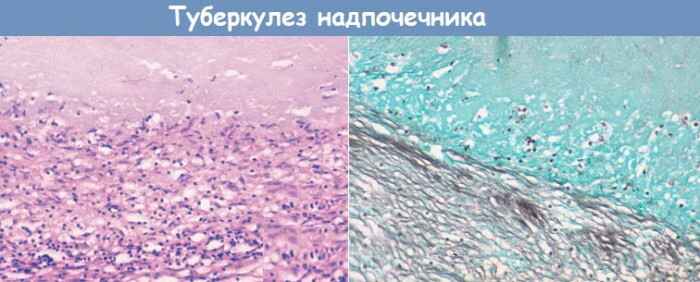
Since tuberculosis infection causes the destruction of the adrenal cortex, then primary adrenal insufficiency develops. In pathology, tuberculous granuloma, caseous necrosis, fibrosis and calcification are usually detected.
Symptoms of adrenal insufficiency that appear in women are most often expressed in the form of fatigue, abdominal pain. In the future, if> 90% of the cortex is affected, a serious problem may appear - an Addison crisis, which is life-threatening.
Inflammation
Inflammation often develops against the background of lesions of the cortex after tuberculosis. Symptoms of inflammation occur only when most of the cortical cells have already been destroyed, and the remainder can no longer compensate for the production of hormones.
A characteristic symptom of the disease is darkening of the skin. A lack of cortisol leads to decreased performance, weight loss, and gastrointestinal complaints such as nausea or vomiting. Aldosterone deficiency leads to a decrease in blood pressure and an increased need for salt, an imbalance in the balance of blood electrolytes, sodium and potassium ions.
Hyperplasia of the adrenal cortex
In this case, there is an overgrowth of one or all 3 layers of the adrenal cortex. Hyperplasia can be congenital or acquired.  The first is the result of improper cortisol biosynthesis. Acquired hyperplasia results from an increased release of adrenocorticotropic hormone, such as from a pituitary adenoma or Cushing's syndrome.
The first is the result of improper cortisol biosynthesis. Acquired hyperplasia results from an increased release of adrenocorticotropic hormone, such as from a pituitary adenoma or Cushing's syndrome.
Cyst
An abnormal cavity in the adrenal gland tissue is a unilateral lesion usually found incidentally during imaging or surgery.
There are 4 categories of cysts:
- Endothelial. The most common form, which is usually benign and not associated with any symptoms.
- Epithelial cysts. They are relatively less common and are also not associated with any serious symptoms.
- Pseudocysts. It is estimated that about 1/3 of all adrenal cysts fall into this category. Pseudocysts can become malignant tumors.
- Parasitic. They are the rarest of all categories, often caused by the larvae of the parasite E. Granulosus.
Treatment is only required when the cyst is showing symptoms. Detailed computed tomography is done to determine the number of cysts and also to determine their exact location. Surgical removal is recommended for cysts at risk of transformation into malignant tumors.
Malignant tumor
Most types of adrenal tumors are benign. They usually do not cause symptoms and do not require treatment. Malignant ones are rare.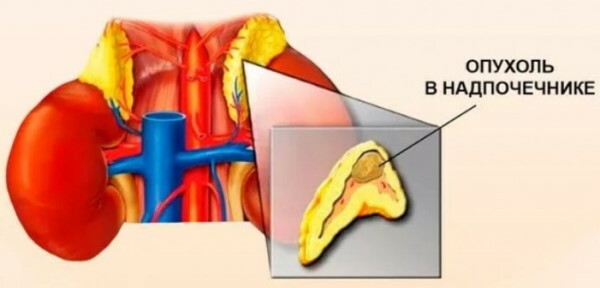
There are two main types of adrenal cortex tumors:
- Adenomas (benign tumors)
- Carcinomas (malignant or cancerous tumors)
Adrenal problems (symptoms in women almost always include feeling tired, irritability) in the form of cancerous tumors are accidentally discovered during imaging performed in search of other diseases.
Symptoms appear when the growths become large and press on other abdominal organs, causing pain or a feeling of bloating. Typically, adrenal cancer is much larger than an adrenal adenoma. A tumor larger than 5-6 cm is considered cancer.
Not all cancers found in the adrenal gland originate from the gland itself. Most are metastatic or spread by cancer from a primary tumor to other organs or tissues. For example, lung cancer, melanoma, and breast cancer often spread (metastasize) through the bloodstream to the adrenal glands. When other cancers have spread to the glands, they are not considered adrenal cancer. They are named and considered depending on where they started from.
Diagnostic methods
For all diseases of the adrenal glands, the diagnosis is made by an endocrinologist on the basis of:
- symptoms;
- family and personal history;
- survey about background diseases;
- genetics;
- taking various medications (for example, steroids that can cause adrenal dysfunction).
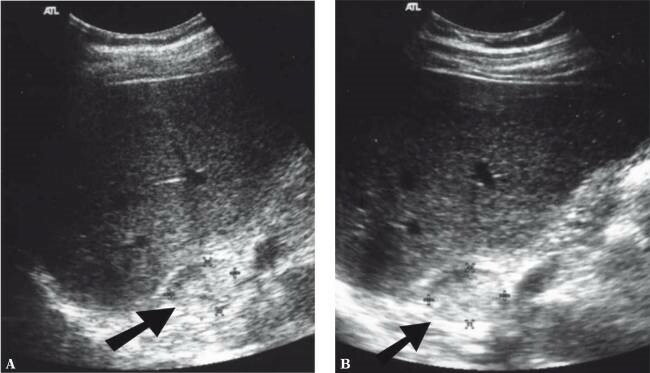
In addition, laboratory tests are performed to measure cortisol levels, ACTH levels, and other hormones associated with the glands. If a tumor is suspected, a biopsy and various imaging tests, such as CT, MRI, will be required.
Methods for treating adrenal diseases
Adrenal problems (symptoms in women depend on which hormone is not fully produced) are resolved with appropriate treatment. Therapy should be appropriate for the patient's age, disease, and underlying cause. In general, changes in adrenal function are divided into disorders that cause hyperactivity and disorders that cause hypoactivity.
Hormone replacement therapy is given if adrenal gland function is found to be low, such as that caused by Addison's disease. In the case of various tumors, benign or malignant, surgery, chemotherapy, radiation and hormone therapy are often required. In the case of genetic diseases, treatment is symptomatic.
Drug therapy
The basis of medication treatment is the restoration of hormonal levels. For this, drugs containing synthetic hormones are used.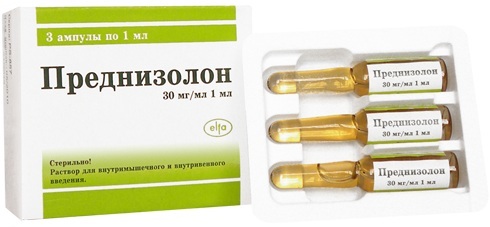
| Disease | Drug treatment | Drugs |
| Adrenal insufficiency | Mineralocorticoids | Fludrocortisone |
| Glucocorticoids | Prednisolone. Hydrocortisone |
|
| Inflammation | Glucocorticoids | Hydrocortisone Fludrocortisone Dexamethasone |
| Hyperaldosteronism | A drug that suppresses the conversion of cholesterol to 20-alpha-hydroxycholesterol, as well as suppresses all processes of steroid formation | Aminoglutethimide |
| A diuretic that stores potassium in the body and acts as an aldosterone antagonist | Spironolactone |

At the next stages, antiviral, antibacterial drugs are prescribed to reduce and eliminate negative factors affecting the work of the adrenal glands. If necessary, vitamin supplements are prescribed.
Non-drug treatment
The adrenal glands produce various activating hormones and substances (neurotransmitters). They prepare the body for stress and stress. If adrenal function is weakened, the body reacts sluggishly to cold, hunger, toxins, illness, or physical and mental stress.
Micronutrient medicine employs 3 strategies in nutritional supplementation: first, to reduce stress, secondly, to mitigate the effects of stress and, thirdly, to strengthen the adrenal glands so that they can again produce hormones.
The following nutrients are recommended:
- B vitamins as nerve food.
- Vitamin C to reduce stress response.
- Vitamin D to improve mood.
- Magnesium against the effects of stress.
- Omega-3 fatty acids to protect nerve cells.
- Tryptophan, as a precursor to the soothing and sleep-promoting hormones of happiness.
- Theanine for relaxation.
Surgery
Surgery is the main treatment option for pheochromocytoma, a tumor of the adrenal medulla that produces excess catecholamines. Surgery is the removal of a tumor and, if necessary, some of the surrounding healthy tissue during surgery.
- Adrenalectomy is the surgical removal of an adrenal gland with a tumor.
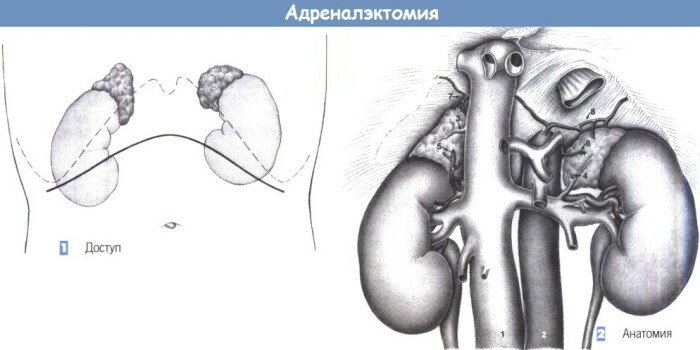
- If the tumor is less than 5 cm and does not show signs of a malignant tumor, then laparoscopic surgery is possible. The procedure can be performed from the abdomen or back, depending on the location of the tumor and the surgeon's experience.
- If the tumor is malignant or larger than 5 cm, surgery using a larger incision in the abdomen or back is recommended. If the patient has previously had abdominal surgery, the incision in the back may be easier.
Why are adrenal diseases dangerous, consequences and predictions
The prognosis for adrenal inflammation with concomitant adrenal insufficiency is good. Sick people do not have a reduced life expectancy, and they can continue to live and work normally. It is important to take the medication correctly to mimic adrenal function as much as possible. Regular check-ups with a doctor are equally important to determine if any medication adjustments are necessary.
- People with classic adrenal hyperplasia are at risk of adrenal crisis because they have very low blood cortisol levels. It can cause diarrhea, vomiting, dehydration, low blood sugar, and shock. An adrenal crisis is a life-threatening situation that requires immediate treatment. Aldosterone levels can also be low, leading to dehydration and decreased sodium and potassium levels. The woman may develop fertility problems.
- Most benign adrenal tumors are asymptomatic and require no treatment. But sometimes they release high levels of certain hormones that can cause complications.
- If Addison's disease is left untreated, a crisis can develop as a result of physical stress such as injury, infection, or illness. Typically, the adrenal glands produce 2 to 3 times more cortisol in response to exercise. In adrenal insufficiency, the inability to increase cortisol production under stress can lead to addisonic crisis - a life-threatening situation, when the pressure drops, the level of sugar in the blood decreases, and the level of potassium in the blood rises
- People with some rare hereditary diseases have an increased risk of pheochromocytoma or paraganglioma. Tumors associated with these diseases are more likely to be malignant. In this case, complications develop: heart disease, renal failure, problems with the optic nerves.
The quality of life of men and women in particular directly depends on the state of the endocrine glands. In general, adrenal abnormalities are usually rare. But if problems have arisen, alarming symptoms have appeared, you should discuss them with your doctor in time.
Adrenal video
Adrenal glands and stress:



